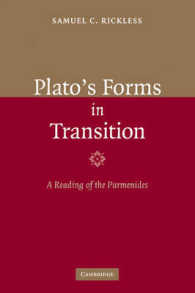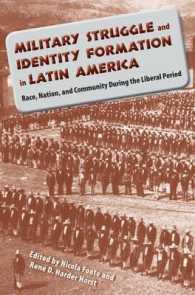Full Description
An Introduction to English grammar provides a comprehensive overview of all aspects of English grammar, and can be used in the classroom, for self-study, or as a reference book. The book is organised in two parts - on grammar and its applications - and provides everything a beginning student needs to get to grips with the theory and practice of English usage, including sections on style, punctuation and spelling. This third edition has been fully revised and updated to include an expanded section on English in Use, usage notes highlighting common errors, updated exercises, a glossary and a companion website with further graded exercises.
Contents
Proposed Table of Content Preface to the Third Edition Acknowledgements Introduction i. What is grammar? ii. Grammar and other aspects of language iii. Grammars of English iv. National and regional varieties v. Standard English and non-standard English vi. Variation according to use vii. Descriptive rules and prescriptive rules viii. Why study grammar? ix. How this book is organised PART 1: THE GRAMMAR Chapter 1. The Parts of a Simple Sentence 1.1 How we analyse sentences: Structure, form, and function 1.2 Subject, predicate, and verb 1.3 The operator 1.4 Do, Be, and Have 1.5 Subject and verb 1.6 Subject 1.7 Transitive verbs and direct object 1.8 Direct object and indirect object 1.9 Direct object and object complement 1.10 Linking verbs and subject complement 1.11 Intransitive verbs and adverbials 1.12 Adverbial complement 1.13 The meanings of the sentence elements 1.14 The basic sentence structures EXERCISES Chapter 2. Word Classes 2.1 Open and closed classes 2.2 Word classes and word uses 2.3 NOUNS 2.4 Noun classes 2.5 Number 2.6 Genitives 2.7 MAIN VERBS 2.8 Regular verbs and irregular verbs 2.9 Classes of irregular verbs 2.10 AUXILIARY VERBS 2.11 The passive auxiliary 2.12 The progressive auxiliary 2.13 The perfect auxiliary 2.14 Modal auxiliaries 2.15 The meanings of the modals 2.16 ADJECTIVES 2.16 Attributive adjectives and predicative adjectives 2.17 Gradability and comparison 2.18 ADVERBS 2.19 The meanings of adverbs 2.20 Gradability and comparison 2.21 PRONOUNS 2.22 Personal pronouns 2.23 Possessive pronouns 2.24 Reflexive pronouns 2.25 Demonstrative pronouns 2.26 Reciprocal pronouns 2.27 Interrogative pronouns 2.28 Relative pronouns 2.29 Indefinite pronouns and numerals 2.30 Pronoun one 2.31 DETERMINERS 2.32 Central determiners 2.33 Predeterminers 2.34 Postdeterminers 2.35 The articles and reference 2.36 PREPOSITIONS 2.37 CONJUNCTIONS EXERCISES Chapter 3. The Structures of Phrases 3.1 The phrase types 3.2 NOUN PHRASES 3.3 Central determiners 3.4 Premodifiers 3.5 Postmodifiers 3.6 Relative clauses 3.7 Appositive clauses 3.8 Coordination of noun phrases 3.9 Noun phrase complexity 3.10 Functions of noun phrases 3.11 VERB PHRASES 3.12 The forms of main verbs 3.13 Tense, person, and number 3.14 Aspect 3.15 Voice 3.16 Expressing future time 3.17 The ordering of auxiliaries 3.18 Finite and non-finite verb phrases 3.19 Mood 3.20 Phrasal verbs 3.21 ADJECTIVE PHRASES 3.22 Functions of adjective phrases 3.23 ADVERB PHRASES 3.24 Functions of adverb phrases 3.25 PREPOSITIONAL PHRASES 3.26 Functions of prepositional phrases EXERCISES Chapter 4 Sentences and Clauses 4.1 Sentence types 4.2 Declaratives 4.2 Questions 4.3 Imperatives 4.4 Exclamatives 4.5 Active sentences and passive sentences 4.6 Positive sentences and negative sentences 4.7 Simple sentences and complex sentences 4.8 Compound sentences 4.9 Subordinate clauses 4.10 Non-finite clauses and verbless clauses 4.11 Functions of subordinate clauses 4.12 There structures 4.13 Cleft sentences 4.14 Anticipatory it EXERCISES PART 2: THE APPLICATIONS Chapter 5. Common Usage Problems SUBJECT-VERB AGREEMENT 5.1 And, or, nor. 5.2 With 5.3 Collective nouns 5.4 Indefinite pronouns 5.5 Quantity phrases 5.6 Singular nouns ending in -s 5.7 Who, which, that 5.8 What 5.9 There is, There are 5.10 Citations and titles CASE 5.11 Subject Complement 5.12 Coordinated phrases 5.13 After as and than 5.14 After but 5.15 After let 5.16 Who, whom 5.17 Case with -ing clauses VERBS AND AUXILIARIES 5.17 Problems with auxiliaries 5.18 Lie, lay 5.19 Present tense 5.20 Past tense and the -ed participle 5.21 Past tense and the past subjunctive 5.22 Multiple negation ADJECTIVES AND ADVERBS 5.23 Confusion between adjectives and adverbs 5.24 Comparison 5.25 Only 5.26 Dangling modifiers EXERCISES Chapter 6 Style in Writing EMPHASIS 6.1 End-focus 6.2 Front-focus 6.3 There-structures and cleft sentences 6.4 Parenthetic expressions CLARITY 6.5 End-weight 6.6 Misplaced expressions 6.7 Abstract nouns 6.8 Modifiers in noun phrases 6.9 Subordination 6.10 Parallelism 6.11 Repeated sounds 6.12 Pronoun reference CONSISTENCY 6.13 Pronoun agreement 6.14 Tense consistency EXERCISES Chapter 7. English in Use 7.1 Register variation 7.2 Spoken English and written English 7.3 The language of conversation 7.4 Unscripted speeches 7.5 Sports c








